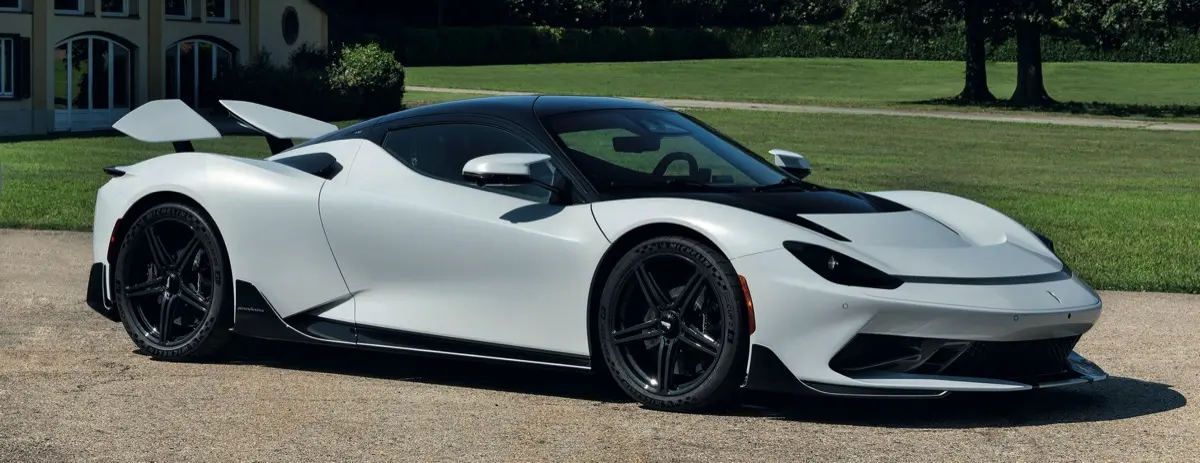BATTISTA THE PININFARINA BATTISTA, STARTING AT A BASE PRICE OF 2 MILLION EUROS, FEATURES INTERIORS MADE FROM OLIVENLEDER® LEATHER, AN INNOVATIVE 100% PLANT-BASED TECHNOLOGY.
One of the world’s most extraordinary and iconic cars now features interiors crafted with Olivenleder®, a trademark owned by wet-green® GmbH who is now a part of Silvateam, following its acquisition from MB-Holding, approximately a year ago.
This strategic partnership has been a pivotal investment in driving sustainable innovation within the leather industry. It delivers a clear and compelling message to the sector: the future lies in eco-friendly, plant-based solutions. “Olivenleder® technology represents a groundbreaking change in leather processing, thanks to its pre-tanning
agent derived from olive extract sourced from pruning waste such as leaves and branches. This solution produces a vegetable-tanned leather with a nappa-like texture that is soft and fast to manufacture,” Silvateam explains.
The company’s expertise in supply chain management and plant tannin extraction will optimize the production of Olivenleder® tanning agents, ensuring scalability for industrial use. Additionally, Olivenleder® integrates seamlessly with Silvateam’s biocircular Ecotan® product line.
The common goal of both tanning technologies is to protect the environment, embracing a green strategy geared toward the future, including in the automotive sector. “The decision to adopt Ecotan® or Olivenleder® will allow brands to reduce their environmental impact, strengthen their value proposition in the market and optimize production,” the company stated.
A JEWEL IN THE CROWN OF AUTOMOTIVE DESIGN
To be featured in the interiors of the Pininfarina Battista, a two-seater electric hypercar produced by the Italian – German Automobili Pininfarina, is a standout achievement for Silvateam. The vehicle, named in honor of Battista Farina, founder of the renowned design firm, is a unique masterpiece. Production is limited to 150 units, assembled at the Cambiano (Turin) plant, and evenly distributed across North America, Europe, Asia, and the Middle East.
During its unveiling at the Geneva Motor Show in January 2019, Pininfarina announced a base price of 2 million euros, with the cost reaching up to 2.5 million euros. The Battista is the most powerful street-legal car ever designed and built in Italy, capable of reaching a top speed of 350 km/h.
SUSTAINABLE LUXURY FOR THE MOST DISCERNING CLIENTS
“Our most demanding clients,” explains Sara Campagnolo, Colour and Materials Design Director at Automobili Pininfarina, “can choose light brown sustainable luxury leather for the Battista’s interiors, which can also be used for the accompanying luggage set. The vegetable tanned leather is not only 100% chrome-free but also metal-free, sustainably crafted using a tanning agent derived from pruning waste of Italian olive trees and is available in a wide range of colors. This process eliminates chemical tanning agents, minimizing the environmental impact of Battista’s artisanal production. The semi-aniline leather, exquisitely soft, is inspected and certified by an independent commission dedicated to sustainable innovation.”
A PALETTE INSPIRED BY PIEDMONT
Owners of the Battista can customize their car’s color through a groundbreaking bespoke program. Among the available options is a specially curated palette inspired by the Piedmont region in northern Italy. This region, home to Automobili Pininfarina, remains a hub of creativity and craftsmanship.
“We selected the most iconic locations in Piedmont and named the paint colors after them,” Campagnolo notes. “For instance, Nero Torino pays homage to the regional capital, Blu Savoia references the House of Savoy, which ruled Turin in the 15th century, and Verde Valentino takes its name from the city’s principal park. Altogether, there are nearly 30 colors available, offering a wide and varied range of choices.”
The integration of sustainable materials like Olivenleder® into such an exceptional vehicle demonstrates how luxury and environmental responsibility can coexist, setting a new benchmark for the automotive and leather industries alike.

